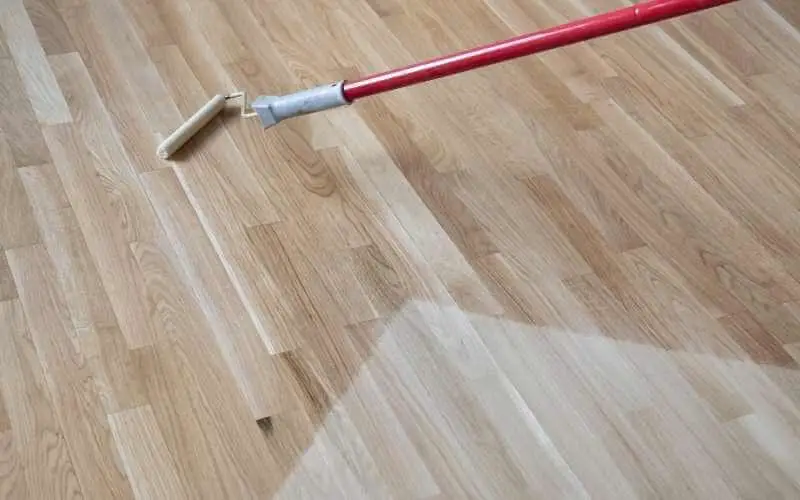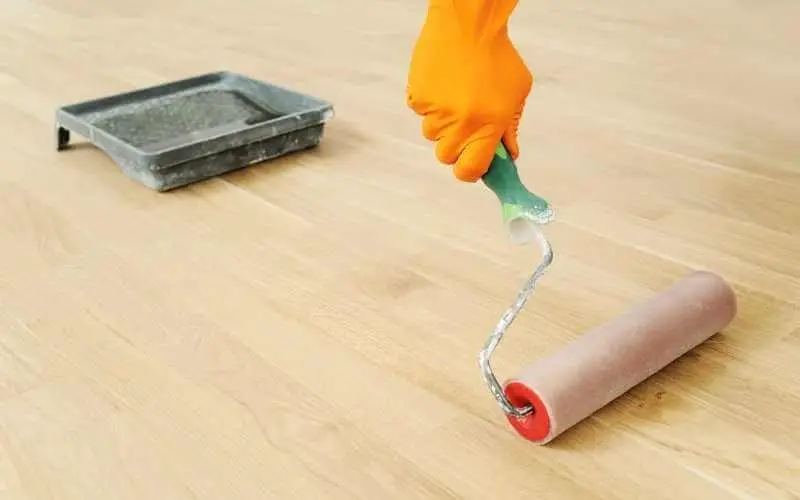Polyurethane is an oil-based varnish with a transparent finish; it self-levels and adheres firmly to any flooring it is applied to; it is also highly durable and easy to apply.
Before applying oil-based polyurethane to wood floors, ensure to read the manufacturer’s instructions on how to go about the application and the product’s contents.
This article discusses useful information on how to go about how to apply oil-based polyurethane to wood floors.
The procedure begins with sanding, cleaning the floor, then three series of coating with drying times between each coating, this enables the applied polyurethane finish to adhere better to the floor, and this will help you to get professional results.
Realated: How to clean oiled wood floor
How to Apply Oil-Based Polyurethane to Wood Floors
Table of Contents
Before applying oil-based polyurethane, you might want to take the day off as this type of finish take more time to dry compared to water-based varieties, but it works exceedingly well in restoring the shine and luster of your wood floors.
The application process isn’t very difficult, and you will achieve a better result if you follow the following technique on how to apply oil-based polyurethane to wood floors, carefully focusing on every detail.
You’ll need:
- Oil-based polyurethane
- Roller pad or applicator
- Mixing stick
- White vinegar
- Natural bristle brush
- Face mask
- 80 & 220-grit sandpaper
- Hand gloves
- Vacuum
- Sander machine
- Container
- Cutting pad
- Clean microfiber rug and a lint-free rag
Step 1: Sand the Floor
Before applying polyurethane to wood floors, you would need to sand it down, whether it has a finish on it or not.
When sanded, the wood floor is prepared for the final finishing. You’ll need a floor sander to sand your wood floor, and you can rent or purchase it from your local hardware store. Use the sander according to the manufacturer’s instructions.
If you are giving your wood floor a total refinish and altering the color of the floor or fixing completely worn-out areas, you would need to sand the floor down to bare wood.
But if your floor’s existing finish is still in a fine state and has no worn-out or pilled areas, you should only screen and re-coat the floor. Sand your floor carefully according to its actual condition.
Read: Sanding wood floor with hand belt sander
Step 2: Clean the Floor
Cleaning your floor after sanding is very important as dust or other dust-type particles can ruin oil-based polyurethane application; when left on the floor, they make it difficult to apply a smooth topcoat.
So after sanding, use a vacuum suitable for wood floors to clean the floor thoroughly, then go in with a lint-free rag or microfiber cloth to mop the floor surface.
Next, dampen a cloth with mineral spirits and clean all the dust off the edges and corners of the room with it. Now you can begin the application of polyurethane coating or stain on the floor.
Step 3: Preparing Liquid
Transfer the polyurethane from its package into a container so you can mix all the liquid together perfectly.
Use a painting stick and stir the polyurethane liquid until it releases all the trapped air bubbles inside the liquid. If you allow the liquid to sit overnight, you would need to stir again before using.
Ensure to use a container that is wide enough to contain the liquid and also has enough room for inserting the applicator effortlessly.
Step 4: Coat the Edges
When applying oil-based polyurethane to wood floors, you need to start with the corners first. Use a bristle brush or cutting pads to gently apply the polyurethane liquid to the floor edges.
Step 5: Apply First Coating
Before applying the first coating on the floor, you need to decide the best application method depending on your floor’s situation and the amount of time you have on hand.
A roller with a long handle will ensure a quicker application for large hall rooms, and you are able to apply the polyurethane successfully without bubbles, but you get a detailed application using a paintbrush.
You can also apply polyurethane to wood floors using lambswool; you simply need to insert the applicator into the polyurethane can and coat the floor surface.
To apply a thin coat you can, use a bristle brush; this is very effective, especially on flat surfaces. Begin coating from the farthest end of the room and work your way slowly to the doorway.
Read: How often should you burnish a floor
Step 6: Allow The Floor To Dry
After applying the first coating, allow the polyurethane liquid to dry. Keep the area sealed during this period, so no dust or water droplet enters the room. Also, keep foot traffic and pets away from the room.
Allow the polyurethane finish to dry for 5-8 hours, a drying time less than 12 hours is ideal if you do not want to sand between coats. But you will need to let the liquid dry for more than 12 hours if you intend to sand it down and apply another layer of polyurethane.
Step 7: Apply Second Coat
Before applying the second coat, clean the entire floor surface with a clean cloth soaked with white vinegar. This helps to clean the floor surface and remove any settled dust before applying another coat; you can also clean the floor using a vacuum.
When the floor is free of dust, apply a second coating following the same procedure as the first coating and allow it dry for another 5-8 hours.
Step 8: Apply a Final Coat
When the second coating is dry, you can do the final coating and wrap up the entire process. But, if there is a stain coating on the floor before you apply polyurethane, the floor won’t be needing a third coat; only two coats are required in such cases. But if your floor is bare with no stain, a third and final coat is recommended.
Apply the third coating following similar steps with the previous coats and allow the liquid to dry for another 5-8 hours.
Read: How to fix uneven polyurethane finish on floor
Conclusion
The steps on how to apply oil-based polyurethane to wood floors begins with sanding your floor; this ensures the polyurethane adheres better to the floor; it is followed by a thorough clean with soapy water and mineral spirit, then series of coating.
You may need to apply two or three coatings of polyurethane depending on the condition of your floor (presence of a previous stain on the floor); following the guide above will ensure you end you with an effectively refinished floor.

